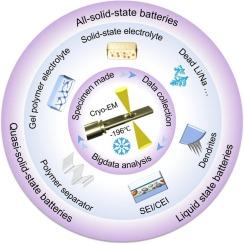Unveiling interphase and other soft matter in liquid and solid-state batteries by cryogenic electron microscopy
IF 22
1区 材料科学
Q1 MATERIALS SCIENCE, MULTIDISCIPLINARY
引用次数: 0
Abstract
Soft matter components in rechargeable batteries, such as the electrochemically-formed solid-state interphase layer on electrodes, dendrites, electrolytes, and separators are essential for dynamic performance, cycling stability, and safety. However, their sensitivity to air, moisture, and electron-beam exposure poses challenges for accurate characterization, hindering an objective understanding and the effective design of advanced energy storage systems. Cryogenic electron microscopy (Cryo-EM), an emerging non-destructive imaging technology, offers unique capabilities to probe and analyze the pristine nanostructure and chemical composition of fragile soft matter in various battery systems. This review provides a comprehensive overview of the fundamental principles, the optimized workflows of sample preparation techniques, and key advancements of Cryo-EM in characterizing interphases and other soft matter within batteries. Additionally, the thickness and composition of the interphases captured by Cryo-EM that forms on diverse electrode materials in liquid, gel, and solid-state electrolytes of Li/Na/Zn battery systems are summarized and discussed. Finally, the challenges and the perspectives for Cryo-EM to characterize soft matter in batteries are provided.

用低温电子显微镜揭示液体和固态电池中的间相和其他软物质
可充电电池中的软物质成分,如电化学形成的电极、枝晶、电解质和分离器上的固态间相层,对动态性能、循环稳定性和安全性至关重要。然而,它们对空气、水分和电子束暴露的敏感性给准确表征带来了挑战,阻碍了对先进储能系统的客观理解和有效设计。低温电子显微镜(Cryo-EM)是一种新兴的非破坏性成像技术,它提供了独特的能力来探测和分析各种电池系统中脆弱软物质的原始纳米结构和化学成分。本文综述了Cryo-EM的基本原理,样品制备技术的优化工作流程,以及表征电池内界面相和其他软物质的关键进展。此外,总结和讨论了在Li/Na/Zn电池系统的液体、凝胶和固态电解质中不同电极材料上形成的Cryo-EM捕获的界面相的厚度和组成。最后,提出了Cryo-EM表征电池软物质的挑战和前景。
本文章由计算机程序翻译,如有差异,请以英文原文为准。
求助全文
约1分钟内获得全文
求助全文
来源期刊

Materials Today
工程技术-材料科学:综合
CiteScore
36.30
自引率
1.20%
发文量
237
审稿时长
23 days
期刊介绍:
Materials Today is the leading journal in the Materials Today family, focusing on the latest and most impactful work in the materials science community. With a reputation for excellence in news and reviews, the journal has now expanded its coverage to include original research and aims to be at the forefront of the field.
We welcome comprehensive articles, short communications, and review articles from established leaders in the rapidly evolving fields of materials science and related disciplines. We strive to provide authors with rigorous peer review, fast publication, and maximum exposure for their work. While we only accept the most significant manuscripts, our speedy evaluation process ensures that there are no unnecessary publication delays.
 求助内容:
求助内容: 应助结果提醒方式:
应助结果提醒方式:


